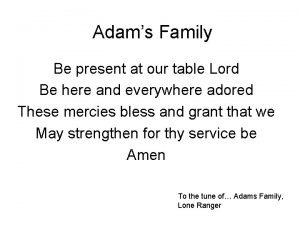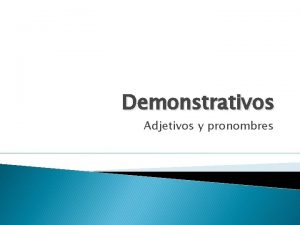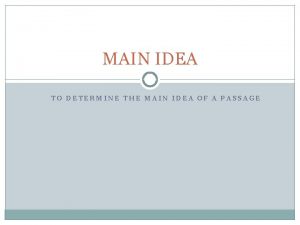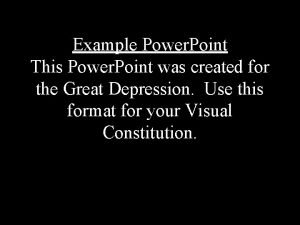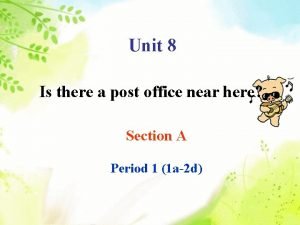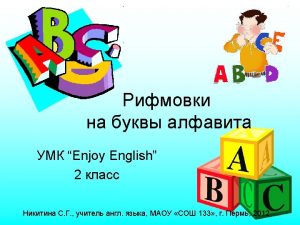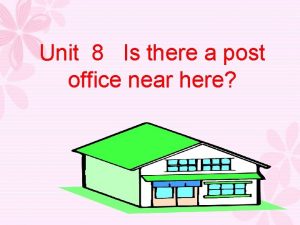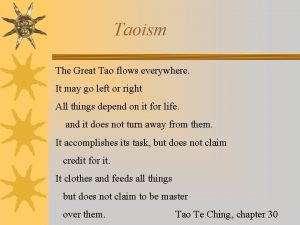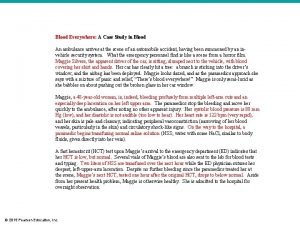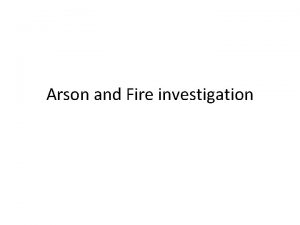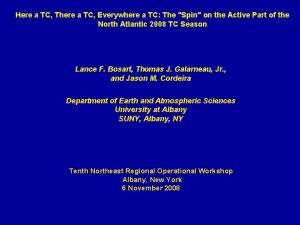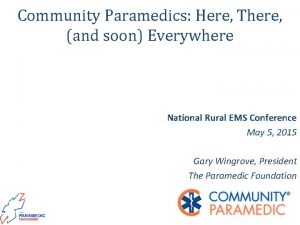From Here to There Physics is Everywhere Investigation

























- Slides: 25

From Here to There Physics is Everywhere! Investigation 1

What are we going to do? n Investigating a couple of fundamental ideas in physics, force and motion n Motion, speed, acceleration, force, gravity and momentum. n 8 Investigations n Test after each investigation

Journal Set Up Force and Motion • Terms, Definitions and Symbols • Equations – 2 columns, 4 rows 2 x 4=8

Part 1 n Flying Air Trolleys

Motion n On a new page in your journal write down a definition.

Air Trolleys! n In order to better understand motion, we should study something that is moving. We have a system here that we can put into motion. n The propeller can be wound up to put energy into the rubber band. n We’ll hook the air trolley on a length of flight (fishing) line and drive it by propeller power.

Material Time n Gather the materials as shown on your construction sheet. n Work as a team to build your trolley and set up your line. – 2 should construct the trolley – 2 should set up the flight line n Flight Line – 5 m – Should not block classroom movement

Play Time n Make a spot in your journal under the word motion and your definition. n Write the word Trolley Observations n Put your trolley in motion n Can you make it go in both directions n Explain in your journal how you make your trolley move n Write down all observations – it will help later

Breakdown n Unhook your flight lines and put the lines all the way in the garbage n Sit down and open your journal n Write down the word Discussion

Trolley Discussion n Did you successfully get the trolley to move? n How? Make sure you have explained how you were able to move the trolley? n How do you know it moved? What evidence do you have that it moved? n Write down your answer.

Movement Discussion would you describe the trolley’s movement to someone who wasn’t here to see it? Write down your answer. n Everything has to be someplace. In physics we refer to the place where something is as its position. You have a position, your notebook has a position, and your air trolley has a position. n How

Movement Cont. n The symbol used in physics to indicate position is the lowercase x. Where have you seen X used to indicate the position of something? n How can we show this on paper? n In your journal draw a flight line and show the beginning position and ending position of your trolley flight.

Positions n If x indicates the position of something, it looks like the trolley is in two places at once. Is that possible? n How can we tell the two positions apart? n Which is the starting position and which is the ending position? n Did the trolley go in this direction or that direction?

Initial and Final n In physics an object’s starting position is called its initial position. Its ending position is called its final position. The way you write this is x with a subscript i or subscript f. n Initial position = xi n Final position = xf n Add these to your terms and symbols page

Now What? n Our picture now indicates that the trolley moved, and it indicates the direction it moved. n What other information would help a stranger understand the movement of the trolley even better? (Write this in your journal. ) n Write your ideas in your journal under the question.

Distance n The distance an object traveled is another important piece of information about movement. n Distance can be measured in standard metric units, like meters, centimeters, kilometers and so on. n Distance is how far a moving object went.

Measuring n On the board we have a number line that is calibrated in meters and two trolleys. n One trolley is xi and one is xf n Let’s measure the distance traveled by the trolley on the board. n Mark on the board an arrow indicating where to start measuring and an arrow where to stop measuring. n Measure and record on the board. n Complete WS 7 – Check to see if you’re right!

Measuring cont. n n n Write down the different ways to measure the distance. Which method is best? Why? For objects that are not points (like the air trolleys) it is important to establish a reference point on an object and monitor how far that reference point moves to determine how far the object moves. In this case the reference point can be the back of the trolley, the front of the trolley or any other location on the trolley.

Change of Position n The Greek letter delta is written as a triangle. Delta is a symbol used in physics. Delta means change. n We know that movement is change of position. Delta is change; x is position. Change of position is represented by x.

Add to your terms and symbols page x = change of position n d = distance n Distance is how far something travels, or the amount of change of position. n

Develop a Distance Equation n We will use distance a lot in this course. Sometimes we will measure distance, and sometimes we will calculate distance. When we calculate distance, we’ll use an equation. n Work in your group to figure out the equation for calculating distance, using the symbols we have learned so far. n Start with d =

Distance Equation nd = xf – xi n In many cases the initial position will be at x = 0. In these cases the distance (amount of change of position) is equal to the final position. So d = xf if the initial position is 0. n Complete WS 7 on your own

Terms Check! n Position (x): The location of an object at a given time n Delta ( ): change n Distance (d): the amount of change of position n Motion: change of position n Reference Point: The point on an object used to determine its position and change of position.

Equations Page n In your first equation box add n Distance equation n d = xf – xi

Part 3 Road Race! n Complete WS 10 and 11 n Assessment is next n – Vocabulary check – Assessment
 Everywhere you go everywhere you look
Everywhere you go everywhere you look Thank you lord for giving us food superman
Thank you lord for giving us food superman Here there over there
Here there over there Vcaa scientific poster template
Vcaa scientific poster template Physics ia ideas sports
Physics ia ideas sports There's a place where streams of grace
There's a place where streams of grace My diary from here to there
My diary from here to there It is often said that lightning never strikes
It is often said that lightning never strikes The poem brook
The poem brook There is a crime here that goes beyond denunciation
There is a crime here that goes beyond denunciation We seek him here we seek him there
We seek him here we seek him there Is there _________ post office near here?
Is there _________ post office near here? My diary from here to there activities
My diary from here to there activities Snake apples everywhere
Snake apples everywhere Apples here apples there
Apples here apples there Where is the post office? it is _____ there.
Where is the post office? it is _____ there. Modern physics vs classical physics
Modern physics vs classical physics University physics with modern physics fifteenth edition
University physics with modern physics fifteenth edition I've been everywhere pei
I've been everywhere pei Great tao
Great tao Security that fits everywhere
Security that fits everywhere Linux everywhere
Linux everywhere What is sexist
What is sexist Love relationship and friendship goes everywhere
Love relationship and friendship goes everywhere Clot retraction
Clot retraction Every learner everywhere
Every learner everywhere

